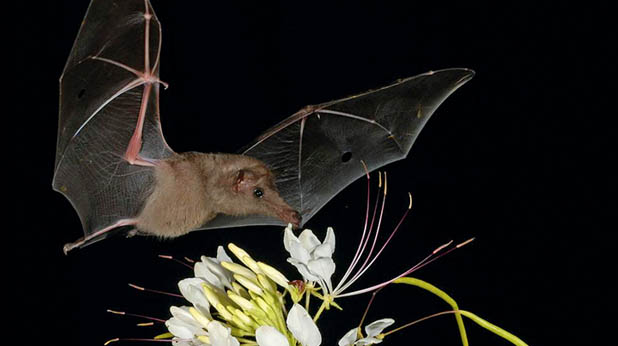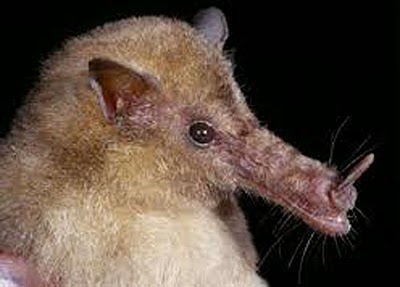Banana bat
The banana bat ( Musonycteris harrisoni ) is a floral bat from the family of the leaf lobes which is native to Mexico. The genus is monotypic Musonycteris, which means that in addition Musonycteris harrisoni no other species of the genus known. The genus name derives from the Arabic word " musa " ( = banana ) and the Greek " Nycteris " ( = bat ) from. The species name honors Ed N. Harrison, who supported the field work of William Joseph scarf roof in Mexico.
Description
The banana bat has the longest snout of all flowers bats. The tongue is more than 76 mm long and optimally adapted to the diet, which consists mainly of nectar adjusted. The banana bat is a medium-sized flowers bat with a total length of an average of 84.8 mm, a forearm length of 42.2 mm and weighing an average of 12.6 g for males and 10.9 g for females. It has as most representative of the family of the sheet tabs a striking nose leaf. The coat is gray - brown in the rule.
Way of life
The banana bat is found only on the Pacific coast of Mexico in thorn savannah and deciduous forests. The region is characterized by highly seasonal, with a rainy season in summer from July to October and a dry season in winter from November to May The banana bat is like most bats nocturnal. The species owes its name to the fact that it was first trapped between banana plants where they apparently searched the banana flower for nectar, pollen and insects. On closer examination it was found in the stomach of this type pollen of various other Night Blooming plants such as Cordia alliodora, Alnus jorulensis, the kapok tree and representatives of the genus of the morning glories. Your diet makes the banana bat therefore likely to be an important seed dispersers and pollinators of these plants. During the day it hangs in small groups in crevices and caves, which it shares with other species such sometimes Glossophaga soricina, Macrotus waterhousii or the commons vampire ( Desmodus rotundus ).
Distribution and habitat
The banana bat is endemic to the Pacific coast of Mexico. The IUCN lists the species because of the relatively small population size and the high probability that the population in the next ten years will fall by 10% as endangered.










